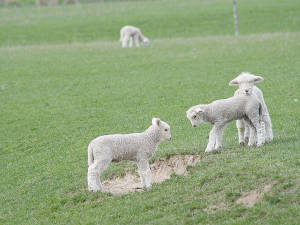How to prevent pneumonia in lambs at weaning
With weaning soon to get underway, some simple management strategies can help prevent the economic losses associated with pneumonia and pleurisy.
 Some simple management ideas can reduce the risk of production limiting diseases like pneumonia and pleurisy in lambs.
Some simple management ideas can reduce the risk of production limiting diseases like pneumonia and pleurisy in lambs.
Weaning, drafting, drenching and shearing create the perfect environment for pneumonia and pleurisy in lambs.
However, some simple management ideas can reduce the risk of these production limiting diseases.
Pneumonia is a disease that causes lesions in the lungs. The most common form is Chronic Non-Progressive Pneumonia which can be caused by bacteria, mycobacteria or viruses.
Symptoms are usually not obvious, although lambs will be slower growing and often pant and cough following exercise.
Lambs with pneumonia are more likely to develop pleurisy, which is where lungs stick to the chest wall. At processing, affected carcasses are downgraded or condemned.
A 2000/2001 study carried out on a database of 1719 farms in Canterbury, Manawatu and Gisborne found the prevalence of pneumonia ranged from 0–100% per flock. But on average, flocks had 24% of lambs affected.
The number of flocks with some pneumonia present ranged from 40–70% – in other words it is very common and costly. Slower growing lambs cost more to feed and then their carcasses are downgraded.
Risk factors include high temperatures and humidity, crowding, stress, dust, excessive exercise, poor ventilation, low immunity and high parasite burdens.
Preventing Pneumonia
|
A landmark moment for New Zealand. That's how Prime Minister Christopher Luxon describes the conclusion of negotiations for an India-New Zealand Free Trade Agreement. Beef Progeny Test 2025: Genetic insights for NZ beef industryAt Pāmu’s Kepler Farm in Manapouri, mating has wrapped up at the across-breed Beef Progeny Test. HortNZ celebrates 20 YearsMore than 150 people turned up at Parliament recently to celebrate the 20th anniversary of Horticulture New Zealand (HortNZ). Biosecurity NZ urges vigilance for yellow-legged hornetsBiosecurity New Zealand says Kiwis should continue to keep an eye out for yellow-legged hornets (Vespa velutina) over the holiday season. Mental Health and Fitness Unite: The Push-Up Challenge comes to New ZealandThe Push-Up Challenge, an event which combines mental health and fitness, is set to launch in New Zealand in 2026. Agritechnica 2025: Claas, Fendt and Valtra claim 2026 Tractor of the Year AwardsLast month's Agritechnica event led to a wide group of manufacturers celebrating successes when the 2026 Tractor of the Year Competition winners, selected by a panel of European journalists, were announced in Hanover Germany. NationalAlliance commissions major heat pump system at Mataura, cutting coal use and emissionsAlliance Group has commissioned a new heat pump system at its Mataura processing plant in Southland.NZ meat industry seeks removal of US 15% lamb tariffMeat processors are hopeful that the additional 15% tariff on lamb exports to the US will also come off.Early drought fears ease in Hawke’s Bay, but caution remainsFears of a serious early drought in Hawke’s Bay have been allayed – for the moment at least.Consent Rollovers and $13b Savings: What the new RMA bills could meanThere was much theatre in the Beehive before the Government's new Resource Management Act (RMA) reform bills were introduced into…Rural bias?OPINION: After years of ever-worsening results from our education system, the startling results from a maths acceleration programme stood out like…Machinery & ProductsAgriSpread AS3000 Bulk Spreader: Precision spreading up to 52mManufactured in Ireland, tested and launched at Agritechnica in Germany, AgriSpread’s new AS3000 bulk spreader takes much of the technology…Agritechnica 2025: Claas, Fendt and Valtra claim 2026 Tractor of the Year AwardsLast month's Agritechnica event led to a wide group of manufacturers celebrating successes when the 2026 Tractor of the Year…New Case IH Puma series debuts with improved design & precision techCase IH used Agritechnica to reveal its new Puma series tractor, featuring what it claims is an entirely new vehicle…New Holland unveils “Il Trattore” concept at AgritechnicaCreating a great deal of enthusiasm at Agritechnica, the T5.120 ‘Il Trattore’ styling concept tractor was celebrating the legacy of…Deutz-Fahr unveils all-new 8 series tractor range at AgritechnicaAgritechnica was the launchpad for several “new” tractors, most reworks of existing models, but Deutz Fahr ‘s new 8 Series was…» Latest Print Issues OnlineThe Hound
Yes, Minister!OPINION: The release of the Natural Environment Bill and Planning Bill to replace the Resource Management Act is a red-letter day… Two-legged pestsOPINION: Federated Farmers has launched a new campaign, swapping ‘The Twelve Days of Christmas’ for ‘The Twelve Pests of Christmas’ to… » Connect with Rural News» eNewsletter |